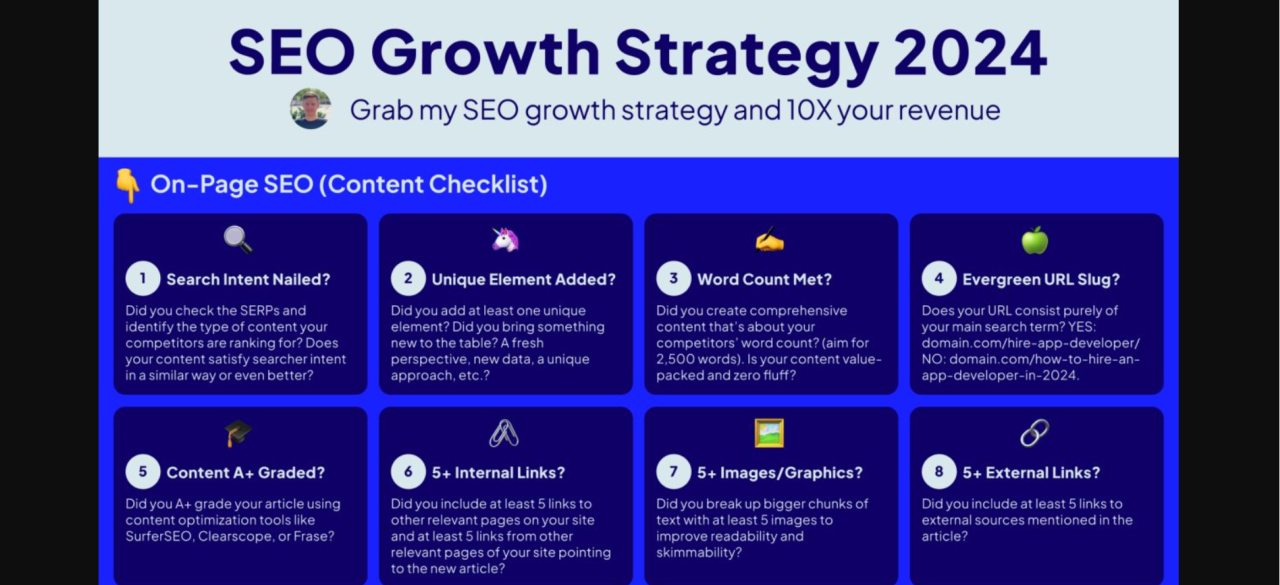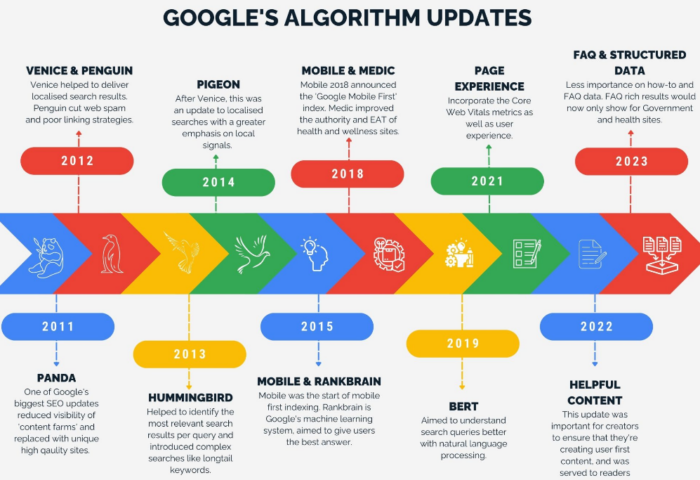Unlock the secrets to conquering Google’s algorithm with these proven SEO strategies that will skyrocket your website to the top.

Image courtesy of via DALL-E 3
Table of Contents
Introduction to SEO and Google Ranking
SEO, which stands for Search Engine Optimization, is a crucial aspect of making sure your website appears at the top of Google search results. Essentially, SEO helps improve your online visibility and allows more people to find your website when they search for relevant terms.
What is SEO?
SEO is like a secret code that you use to tell search engines like Google what your website is all about. By optimizing your website with the right keywords and strategies, you can increase the chances of Google ranking your site higher in search results. This means more people are likely to click on your website, ultimately driving more traffic your way.
Why Does Google Ranking Matter?
Imagine you’re searching for the best pizza place in town. Do you usually scroll through several pages of search results before making a decision? Probably not! That’s why it’s crucial to aim for the first page of Google, as most people tend to click on one of the top results. If your website appears on the first page, you have a better chance of attracting visitors who are looking for what you offer.
Understanding Keywords
In the world of SEO, keywords are like magic words that help search engines like Google understand what your website is all about. When people type words or phrases into the search bar, those are the keywords they are using to find information online. For example, if someone is looking for information on how to bake delicious cookies, they might type in keywords like “cookie recipes” or “how to bake cookies.”
How to Find the Right Keywords?
Choosing the right keywords is crucial for your website to appear on the first page of Google search results. To find the best keywords for your content, think about what words or phrases your target audience is likely to use when searching for information related to your website. You can use tools like Google Keyword Planner to do keyword research and see which keywords are popular and relevant to your content. Remember, the key to effective keyword selection is to choose terms that accurately represent the content on your website and match the search intent of your audience.
On-Page SEO Techniques
Meta tags are snippets of text that describe a page’s content. These tags don’t appear on the actual page but in the HTML code. They play a crucial role in telling search engines what a webpage is about. By including relevant keywords in your meta tags, you can improve your website’s visibility on Google. Make sure to have a unique title tag for each page and a meta description that accurately summarizes the content.

Image courtesy of letterdrop.com via Google Images
Optimizing Content
Content optimization involves crafting high-quality and relevant content that incorporates your chosen keywords naturally. When creating content for your website, think about what users are searching for and provide valuable information that addresses their needs. Avoid keyword stuffing, as this can harm your SEO efforts. Instead, focus on producing engaging and informative content that resonates with your audience.
Off-Page SEO Techniques
One crucial aspect of off-page SEO is building backlinks. Backlinks are links from other websites that direct users to your site. They act as a vote of confidence in the quality and relevance of your content. The more backlinks you have from reputable sources, the more authority your website gains in the eyes of search engines like Google.
Social Media and SEO
Social media plays a significant role in off-page SEO. Being active on platforms like Facebook, Twitter, and Instagram helps in promoting your content and driving traffic to your website. When your content is shared across social media channels, it can attract more backlinks and improve your website’s visibility in search engine results pages.
Technical SEO Tips
Site speed refers to how quickly your website loads when someone visits it. Having a fast-loading website is essential because no one likes waiting for a slow website to load. Google also considers site speed as a ranking factor, meaning that faster websites tend to rank higher in search results.

Image courtesy of jumpto1.com via Google Images
Ensuring Mobile-Friendliness
With more and more people using their smartphones and tablets to browse the internet, it’s crucial to have a website that is mobile-friendly. This means that your website should look good and function well on all devices, including mobile phones and tablets.
Optimizing your site for mobile devices involves ensuring that your website is responsive, meaning it adjusts to different screen sizes, and that buttons and links are easy to tap with a finger. By making your website mobile-friendly, you not only provide a better user experience but also improve your chances of ranking higher on Google.
Content Creation Strategies
Creating blog posts is a key strategy for improving your website’s SEO. When writing blog posts, make sure to include relevant keywords that your target audience is likely to search for. These keywords will help search engines understand what your content is about and show it to the right people.
Additionally, aim to produce high-quality, engaging content that provides value to your readers. This can include answering common questions in your industry, sharing insights and tips, or telling stories that resonate with your audience. The more valuable and relevant your content is, the more likely it is to attract visitors and improve your SEO.
Using Videos and Images
Adding videos and images to your website can also enhance your SEO efforts. Search engines not only look at text content but also at multimedia elements to determine the relevance and quality of a page. Including videos and images that are optimized for search engines can help improve your website’s visibility.
When using videos, make sure to include descriptive titles and alt text that contain relevant keywords. This will help search engines understand the content of your videos and show them in search results. Similarly, optimize your images by including descriptive file names and alt text that includes relevant keywords.
Tracking and Measuring SEO Success
Once you’ve implemented various SEO strategies to improve your website’s ranking on Google, it’s essential to track and measure your progress. By monitoring key metrics and using analytics tools, you can gain valuable insights into what’s working well and what needs adjustment. Here’s how you can track and measure your SEO success:

Image courtesy of www.linkedin.com via Google Images
Using Analytics Tools
Google Analytics is a powerful tool that allows you to track website traffic, user behavior, and conversion rates. By setting up Google Analytics on your website, you can gain valuable insights into which pages are performing well, where your traffic is coming from, and how users are interacting with your site. This data can help you make informed decisions about your SEO strategy and optimize your website for better results.
Understanding SEO Metrics
There are several key metrics you should pay attention to when tracking your SEO success. These include:
- Organic Traffic: The number of visitors that come to your site through organic search results.
- Keyword Rankings: Monitoring where your website ranks for important keywords.
- Click-Through Rate (CTR): The percentage of users who click on your website’s link in search results.
- Bounce Rate: The percentage of users who leave your site after viewing only one page.
- Conversion Rate: The percentage of visitors who complete a desired action on your site, such as making a purchase or filling out a contact form.
By regularly monitoring these metrics and analyzing the data, you can identify areas for improvement and make adjustments to your SEO strategy to drive better results.
Common SEO Mistakes to Avoid
Keyword stuffing is when website content is overloaded with keywords in an attempt to manipulate search engine rankings. This practice not only makes your content hard to read for visitors, but search engines like Google also penalize websites that engage in keyword stuffing. Instead of stuffing your content with keywords, focus on using them naturally and strategically. Think about what words people would use to search for your content and incorporate them in a way that sounds natural and adds value to your text.
Steering Clear of Duplicate Content
Duplicate content refers to blocks of content either within a single website or across different websites that are identical or substantially similar. While it might be tempting to duplicate content to save time, search engines aim to provide unique and relevant content to their users. Having duplicate content can confuse search engines about which version to rank, potentially leading to a decrease in your website’s visibility. To avoid this issue, ensure that all your content is original and adds value to your audience. You can use tools like Copyscape to check for any duplicate content and make necessary edits to maintain the uniqueness of your website.
Conclusion
In conclusion, understanding SEO strategies is crucial for improving your website’s Google ranking and increasing online visibility. By implementing the right SEO techniques, you can attract more visitors and potential customers to your site. Remember, SEO is a continuous process that requires dedication and patience. Let’s summarize the key points we covered in this article to help you on your journey to better Google ranking.

Image courtesy of neilpatel.com via Google Images
Firstly, we delved into the importance of keywords for SEO. Choosing the right keywords and incorporating them strategically into your content is essential for ranking higher on Google. Next, we discussed on-page SEO techniques such as using meta tags and optimizing your content to make it more search-engine-friendly.
Additionally, off-page SEO techniques like building backlinks and engaging on social media platforms can significantly impact your website’s credibility and authority. Technical aspects such as site speed and mobile-friendliness should not be overlooked, as they play a crucial role in SEO success.
Furthermore, creating engaging and SEO-friendly content through blog posts, videos, and images can attract and retain visitors on your site. It’s also vital to track and measure your SEO progress using analytics tools to understand what is working and what needs improvement.
Lastly, we highlighted some common SEO mistakes to avoid, such as keyword stuffing and duplicate content. By staying clear of these errors, you can ensure that your website’s ranking isn’t negatively affected.
By following these SEO strategies and implementing the tips provided in this article, you can boost your website’s Google ranking and increase your online visibility. Remember, SEO is an ongoing process, so continue to monitor your progress and make necessary adjustments to stay ahead in the digital landscape.
Frequently Asked Questions (FAQs)
How long does it take to see SEO results?
When it comes to seeing improvements in your Google ranking through SEO efforts, patience is key. The timeframe for noticeable results can vary depending on several factors, such as the competitiveness of the keywords you are targeting, the quality of your content, and the overall health of your website. In general, it may take anywhere from a few weeks to several months to see significant changes in your search engine rankings.
Can I do SEO myself or do I need an expert?
While managing SEO on your own is entirely possible, enlisting the help of an expert can greatly enhance the effectiveness of your efforts. SEO can be complex and time-consuming, requiring a good understanding of search engine algorithms and best practices. An experienced SEO professional can provide valuable insight, implement advanced strategies, and save you time in the long run. However, if you have the time and dedication to learn and implement SEO techniques effectively, managing it yourself is a viable option.







